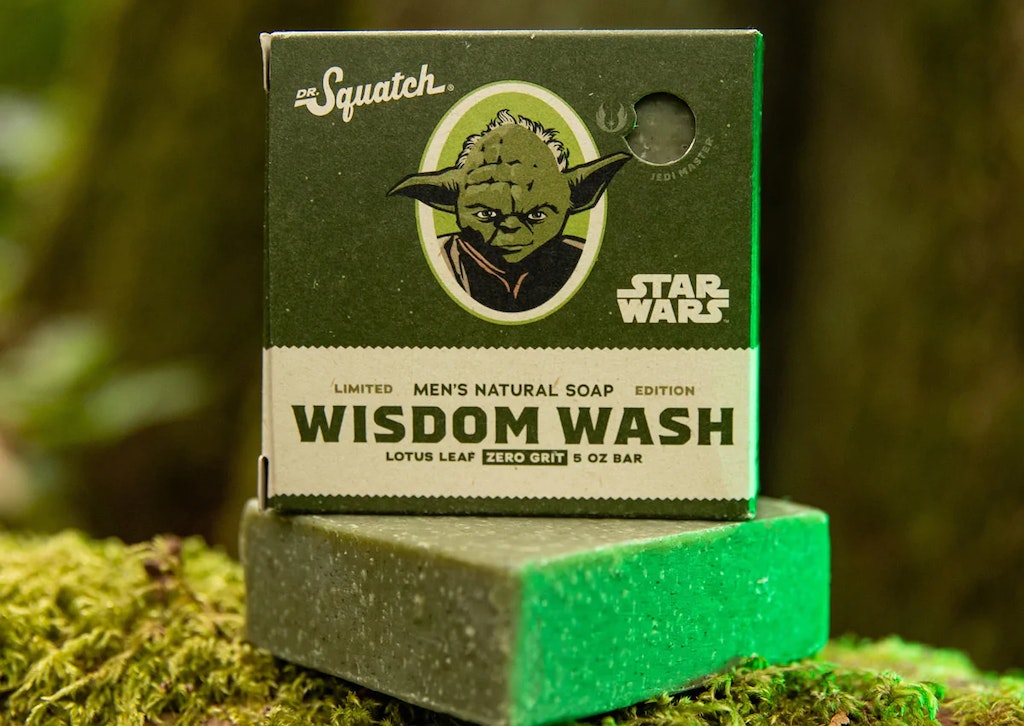Dr. Squatch was founded in 2013 with the goal of differentiating itself from the commoditized men’s personal care industry. At that time, the industry was struggling to build brand loyalty with its core customer base. Dr. Squatch believed that entertaining and engaging content could transform the industry, and this approach proved successful as the company rapidly became one of the world’s fastest-growing consumer brands thanks to its use of satire and outrageous humor.
In 2021, Cody Griffin joined Dr. Squatch as the VP of Marketing. He and his team have been working to find new audiences and customer bases to drive incremental demand. One of the strategies they have employed is leveraging intellectual properties (IPs) from franchises such as Star Wars and Batman to create unique partnerships.
We recently interviewed Cody to learn more about how he and his team have developed and executed these IP partnerships, which have helped to drive business growth.
The Genisis. Dr. Squatch initially explored leveraging licensed IP because they were in hypergrowth mode – trying to acquire any and every customer they could at a reasonable cost. They had seen success reaching new audiences with smaller, limited-edition product releases that leaned into pop culture moments.
Dr. Squatch’s first limited edition product release was their “Area 51” soap. For those of you unfamiliar with Area 51, it became a viral meme after a Facebook group in 2017 was formed “Storm Area 51, They Can’t Stop All of Us.” Inspired by the covert Nevada military base that many have long believed to be some kind of alien testing ground or site where the government is investigating unidentified aerial phenomena, the group proposed gathering as many people as possible on September 20 to cross the fenced-off land. “Let’s see them aliens,” the event description implored.
At that time, the Dr. Squatch team leaned into it because they thought it would be an interesting pop culture moment that was worth integrating into their content. The Dr. Squatch team was pleasantly surprised when their limited edition Area 51 Bricc caught fire and proved to excite and engage their fanbase in a new way.
Cody explained, “We were excited to see how pop culture moments could truly drive incremental demand. There was no regression in our baseline. It was just pure incremental demand. However, it’s relatively hard to capture a cultural moment and convert it into a net new product and bring that to market at the time that it’s still relevant.”
What Cody is referencing is capturing pop culture moments is extraordinarily hit or miss. Timing is a huge factor, but identifying which ones lend themselves to products is significantly more challenging. While their first limited edition Area 51 product launch outperformed expectations, Cody admits that the company’s effort to capture the craze around cryptocurrencies fell short.
By the time Dr. Squatch launched its Crypto Cleanse bar, the crypto market had fallen into winter and the soap did not sell as well as anticipated. However, instead of being discouraged, Cody saw the bigger picture.
If he and his team could systematically design a process for leaning into pop culture, they could increase their odds of driving incremental demand for the business. So they leaned into IP and partnerships.
Licensing Deals. If capturing culturally relevant moments is a difficult but important task, then licensing deals are a way to mitigate the risks associated with capturing these moments in a timely way. Through licensing deals a company is able to get a far broader reach and access new customer bases.
Cody explains, “The reach of our ads is dictated by the content and the consumer base that we have today – but for Star wars, the Meta algorithms will funnel Star Wars content to a lot more people and broaden the audience that we get in a much bigger way.”
In other words, what made licensing deals with companies like Disney or Warner interesting for Cody and his team is that they represented pop culture moments that withstood the test of time. Stars Wars is as relevant to younger generations as it is to older generations and content surrounding the franchise gets distributed to a far wider audience – both things that have proven to be valuable.
As Cody shares, “With licensing deals you have to pay for sharing revenue, and you’re doing things in a way that economically can be harder to make work. So we had to have some incremental strategic advantage. And for us, that was new customer audiences that we wouldn’t have reached otherwise.”
For example, most of Dr. Squatch’s core advertisements do not reach women. However, women could be core buyers of the product who might want to gift the products to their spouses, friends, or other family members. It is easier to reach them with Star Wars content on social media than it is content purely from the brand.
Should Every Brand Use Licensing Deals? The short answer is no.
However, it’s important to think through your brand’s objective and how you can support a licensing deal. Cody and his team at Dr. Squatch have one clear objective in mind every time they engage in an IP deal: new customer acquisition.
For example, he shares, “We anticipated most of our returning customer base would buy [our Star Wars soap collection], but we actually wanted it to be primarily a new customer acquisition tool.”
Although his team is tasked with driving the top-line growth of the business, notice how specific Cody was about the single objective in mind. The effort would only be considered successful if it attracted new customers. Swearing by this one objective helped the team stay focused and aligned on the results they were looking for.
The licensing deal ran for over six months and the results were clear: acquisition costs on Star Wars ad sets were lower than any other ads the brand ran for an extended period. At its peak, Dr. Squatch was acquiring tens of thousands of customers a week with via its Star Wars Collection. They sold hundreds of thousands of these units to new customers because of the reach and impact of the brand.
While this sounds exciting, Cody cautions other brands to be mindful of how much effort Dr. Squatch made to support the deal.
He shares, “ From my perspective, you have to be at a place where you can take advantage of the opportunity. We waited until we knew we could put effectively endless budget behind it until the product and ads no longer performed. Because our objective was to use this for new customer acquisition, we needed to be sure neither operations nor cash flow were constraints on our success.”
If a brand has major budget constraints, it should think twice before pursuing a licensing deal. The time, effort, and capital it takes to make a deal successful are very significant. Licensing deals are effectively a swing for the fences.
How Do Licensing Deals Work? If your brand has never run a licensing deal, that’s okay. Your licensing partners are able to give you a context on whether a product can succeed with certain IP and what to expect for relative demand.
Cody explains, “They see thousands of companies selling their products every quarter and the volume that they get on them, so they know the high level, where you’re going to come in at a relative budget and they can help you come with that. Additionally, we were able to kind of do a lot of surveying with our core customer base and say, how well does this resonate here? So that if it doesn’t do great on the acquisition side, god forbid, are we still covered on the back end from our own customer base? We felt pretty confident in that.”
Licensing deals are two-way partnerships. Successfully negotiating a deal starts with (at least) two things: 1) knowing your brand story and having a strong vision for how to bring the IP to life through your brand; and 2) having a compelling financial reason for why your brand should be able to leverage their IP. Brands need help the IP owner believe that even if they can’t reach new audiences through the IP, their existing customer base will be excited by the product and drive substantial sales.
Cody offers, “Before going to licensing partners we ask ourselves the question of how can we be a partner to support Disney’s goals or Warner’s goals, rather than how can we use you to just give us value? We know that the licensing partner will provide us value.”
Instead, his team demonstrated a clear understanding of what was important to Disney and how they would be the best partner to support those goals.
He shared, “For example, we asked ourselves, ‘What does Disney do best?’ The answer is they tell stories. So then we follow that up with, ‘What does Disney care about most in their storytelling to make sure that that’s successful?’ As we think about a potential partnership, let’s start there, and let’s work with the partnership manager effectively to begin iterating and ideating on stories. Let’s come up with our own point of view on how we’re going to tell this dark side versus the light side in soap format and what that really looks like?”
What Cody is highlighting is crucial to understand. As a company licenses thousands of deals for brands to leverage its IP, your brand will be caught up in the long approval process. One critical tool in your belt is your ability to energize the IP owner to believe your partnership deserves more careful attention.
Once you’ve successfully negotiated a partnership, every studio has very different policies. Some studios will let your licensing contract open you up to multiple IPs. Some of them will do one IP per contract. So for example, Lucasfilm is one IP per contract. And in fact, Star Wars is a separate contract from Mandalorian. Disney is pretty narrow in its relative mindset, at least in the personal care space. It also can change based on whatever category you’re in, which is a pretty unique thing about the licensing world.
Separately, brands need to be prepared for the operational pressure that licensing brings. One thing most operators don’t realize is that when you get approved to license IP, every single aspect of your business that leverages that IP needs to be approved by the IP owner. You are artificially inserting yourself into their universe and therefore they have the right to influence every decision or deny your product entirely if you don’t comply with their guidelines.
Cody shared, “We thought because we’re the product experts and we’re the ones who obviously know what we’re making, we should be in the driver’s seat on this. And creatively you are. We are allowed to pick the scents that work and pick the raw ingredients. But, we have to literally get every component approved by the licensing partner, whether that’s our ingredients, our suppliers need to be approved, our scent descriptions need to be approved, and on and on.”
The IP owner needs a baseline level of revenue out of the partnership because of the labor on their end to approve the brand’s product, and to maintain the brand integrity. So you have to have some fundamental business performance to be able to show them. Building the relationships is crucial to getting a contract signed where you’re allowed to work with them and then getting things through the approval process.
Part 2 Coming Soon. We will be continuing our series on leveraging IP in the coming week with the next exploration surrounding how brands should measure the success of their partnership.

